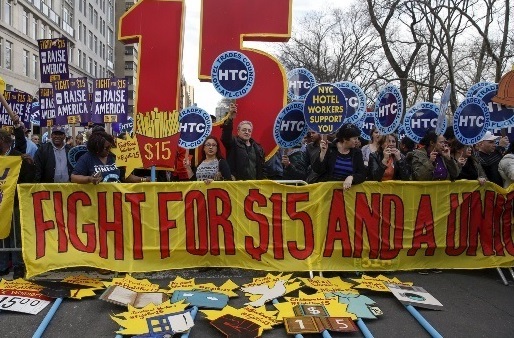
Source: TeleSUR English
By next year, the richest 1% of the world will own more wealth than the rest of the entire population of the planet, according to Oxfam. This is a staggering figure, almost impossible to comprehend. And yet, this fact alone puts into focus a harsh truth: that we live in a fierce, inhuman, capitalist world where a handful of the richest people get richer and more powerful, even as governments across the globe enact austerity measures against the working class.
It is completely ludicrous that governments are carrying out austerity policies while the global 1% are set to clutch over half of the world’s wealth by next year. But here we are, watching the impossible unfold right in front of our eyes.
In Jamaica, IMF-imposed austerity measures are the most severe on the planet, according to the Center for Economic and Policy Research. And, of course, the US is largely to blame. The CEPR explained, “through its leadership role in the IMF, the U.S. is imposing unnecessary pain on Jamaica through harsh austerity and a debt trap.” Since 2007, poverty in the country has doubled, with unemployment currently at 14.2 percent.
While the double stranglehold of debt and austerity brings Jamaica to its knees, activists in Spain are also fighting against government cuts. Earlier this year in Madrid, there was a major mobilization against austerity measures imposed by the government, policies which have worsened homelessness and poverty among the poorest. Protesters carried banners reading “Working for a general strike” and ““Bread, work, a roof and dignity.” Between 2012 and 2014, the Spanish government made $162 billion in spending cuts. The country is experiencing an unemployment rate of 23.7 percent; one out of every four members of the workforce in Spain are unemployed, and half of all young people in Spain between ages 16 and 25 are without jobs. But people are fighting back. Protester Antonio Colmenar told reporters, “It is a day to claim our rights.”
While the 1% fills their pockets, protests against austerity have been rocking the globe. In Montreal, Canada, students are leading the charge against cuts in healthcare, education and public services. “Today, we’re proud to launch a raucous spring,” Fannie Poirier, a spokesperson from the student protest committee told the Montreal Gazette in March. “Austerity measures have been presented as the lesser of evils to confront a deficient economy. But what we’re seeing … is a massive impoverishment of the population, full-frontal attacks on working conditions and a loss of security for society’s most vulnerable people.”
Even in Vermont, a US state known for its progressive politics, Democratic Governor Peter Shumlin has been pushing for austerity measures in education, healthcare and among public sector workers. Steve Howard, executive director of the Vermont State Employees’ Association, commented on Shumlin’s moves to NPR, “Before you take money out of the paychecks of snowplow drivers, nursing assistants, custodians and administrative assistants … we believe you have a moral obligation to ask for a greater contribution from a broad-based revenue source paid mostly by the wealthiest Vermonters who have had all the economic gains of the last decade.”
Austerity is trumpeted by many politicians as a necessary, though painful step to ensure long term economic viability. But it’s simply a way of perpetuating, rather than challenging, capitalist business as usual, a business in which the global 1% get richer and richer while schools go without sufficient funding and workers get laid off.
Governments enacting austerity measures are protecting the 1% and global capitalism. And the 1% has more than its fair share of influence in government policy development. Oxfam reports that the global elite “spent $550 million lobbying policy makers in Washington and Brussels during 2013. During the 2012 US election cycle alone, the financial sector provided $571 million in campaign contributions.”
Meanwhile, according the Harvard Business School, CEOs in America currently make 350 times what the average worker makes, and 774 times as much as minimum wage workers. Such a concentration of wealth not only takes place with impunity in America, it is encouraged as part of free market ideology.
Since 1979, Americans have increased productivity by 80 percent. Yet, according to Forbes, income has not increased at the same rate, if it has increased at all. Furthermore, “the rich spend about 17 percent of their income traveling for business and pleasure” while “the lower classes spend about 17 percent of their income on feeding their families.”
Inequality is not a symptom of the ills of global capitalism, it is its fuel. Austerity measures won’t change this; they simply maintain an unjust system that needs to be transformed from the bottom up. The global 1% and their allies in government need to be confronted and overturned. The entire system needs to be overhauled in a way that puts people, not profits and greed, first.
Luckily, there are exciting movements fighting against this upside down world and proposing alternatives, from Greece to Vermont. “I believe in fighting against the system,” Sara, a protester against austerity measures in Germany told reporters. “It won’t change if you don’t do something.”
***
Benjamin Dangl has worked as a journalist throughout Latin America, covering social movements and politics in the region for over a decade. He is the author of the books Dancing with Dynamite: Social Movements and States in Latin America, and The Price of Fire: Resource Wars and Social Movements in Bolivia. Dangl is currently a doctoral candidate in Latin American History at McGill University, and edits UpsideDownWorld.org, a website on activism and politics in Latin America, and TowardFreedom.com, a progressive perspective on world events. Twitter: https://twitter.com/bendangl Email: BenDangl(at)gmail(dot)com
